HONDA PASSPORT 2000 2.G Owners Manual
Manufacturer: HONDA, Model Year: 2000, Model line: PASSPORT, Model: HONDA PASSPORT 2000 2.GPages: 267, PDF Size: 3.03 MB
Page 171 of 267
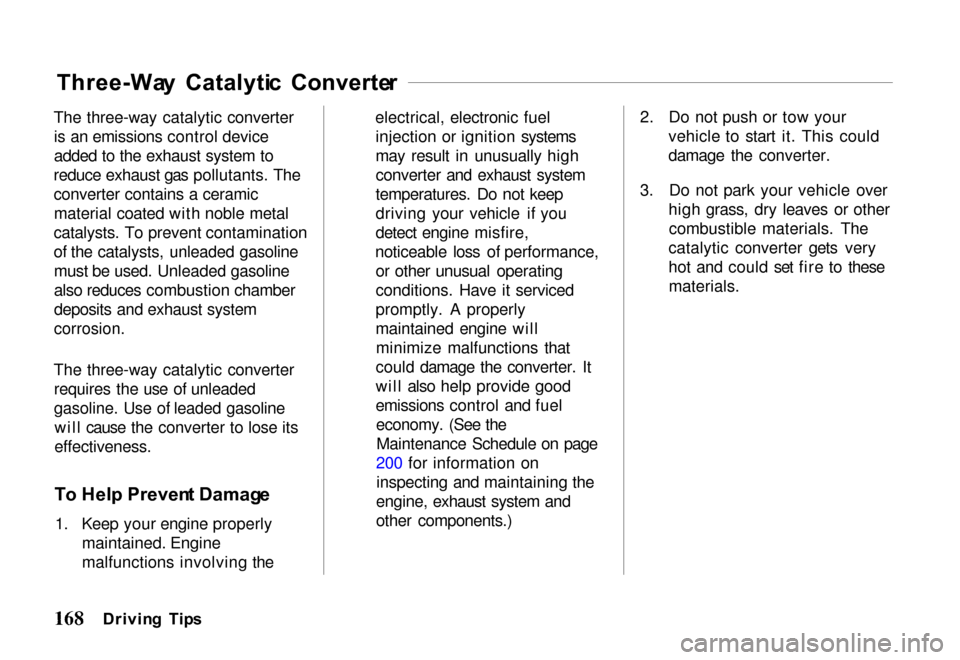
Three-Wa
y Catalyti c Converte r
The three-way catalytic converter is an emissions control device
added to the exhaust system to
reduce exhaust gas pollutants. The
converter contains a ceramic material coated with noble metal
catalysts. To prevent contamination
of the catalysts, unleaded gasoline must be used. Unleaded gasoline
also reduces combustion chamber
deposits and exhaust system
corrosion.
The three-way catalytic converter requires the use of unleaded
gasoline. Use of leaded gasolinewill cause the converter to lose its
effectiveness.
T o Hel p Preven t Damag e
1. Keep your engine properly maintained. Engine
malfunctions involving the electrical, electronic fuel
injection or ignition systems
may result in unusually high
converter and exhaust system
temperatures. Do not keep
driving your vehicle if you
detect engine misfire,
noticeable loss of performance, or other unusual operating
conditions. Have it serviced
promptly. A properly
maintained engine willminimize malfunctions that
could damage the converter. It
will also help provide good
emissions control and fuel economy. (See theMaintenance Schedule on page
200 for information on inspecting and maintaining the
engine, exhaust system and
other components.) 2. Do not push or tow your
vehicle to start it. This could
damage the converter.
3. Do not park your vehicle over high grass, dry leaves or othercombustible materials. The
catalytic converter gets very
hot and could set fire to these materials.
Drivin g Tip s
Page 172 of 267
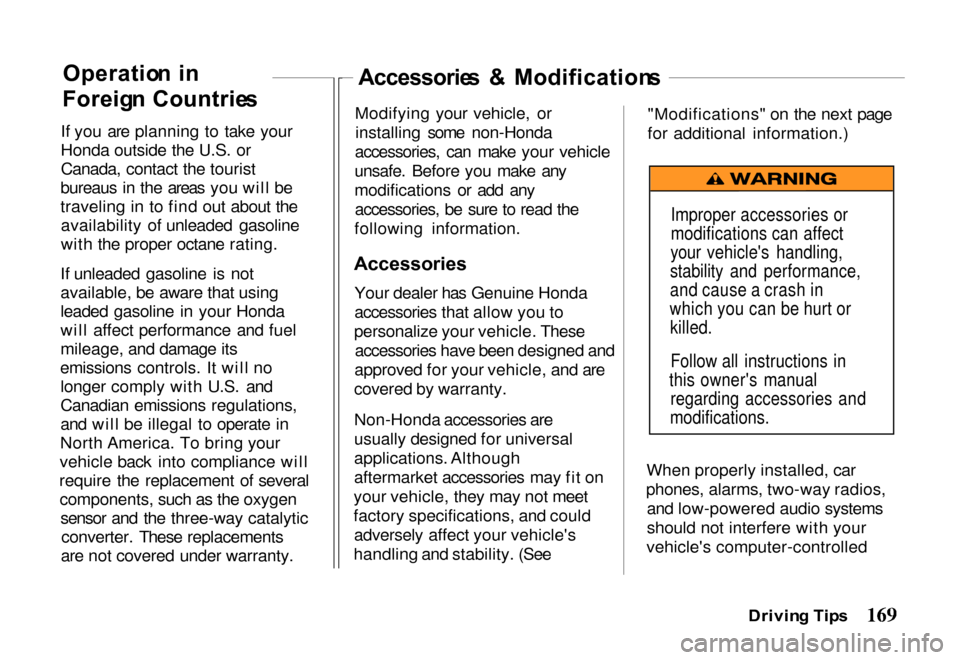
If you are planning to take your
Honda outside the U.S. or
Canada, contact the tourist
bureaus in the areas you will be
traveling in to find out about the availability of unleaded gasoline
with the proper octane rating.
If unleaded gasoline is not
available, be aware that using
leaded gasoline in your Honda
will affect performance and fuel
mileage, and damage its
emissions controls. It will no longer comply with U.S. and
Canadian emissions regulations,
and will be illegal to operate in
North America. To bring your
vehicle back into compliance will
require the replacement of several components, such as the oxygen sensor and the three-way catalyticconverter. These replacements
are not covered under warranty.
Accessorie
s & Modification s
Modifying your vehicle, or installing some non-Honda
accessories, can make your vehicle
unsafe. Before you make any
modifications or add any accessories, be sure to read the
following information.
Accessories
Your dealer has Genuine Honda
accessories that allow you to
personalize your vehicle. These accessories have been designed and
approved for your vehicle, and are
covered by warranty.
Non-Honda accessories are
usually designed for universal
applications. Although
aftermarket accessories may fit on
your vehicle, they may not meet
factory specifications, and could adversely affect your vehicle's
handling and stability. (See "Modifications" on the next page
for additional information.)
When properly installed, car
phones, alarms, two-way radios, and low-powered audio systems
should not interfere with your
vehicle's computer-controlled
Driving Tip s
Operatio
n i n
Foreig n Countrie s
Improper accessories or
modifications can affect
your vehicle's handling,
stability and performance,
and cause a crash in
which you can be hurt or killed.
Follow all instructions in
this owner's manual regarding accessories and
modifications.
Page 173 of 267
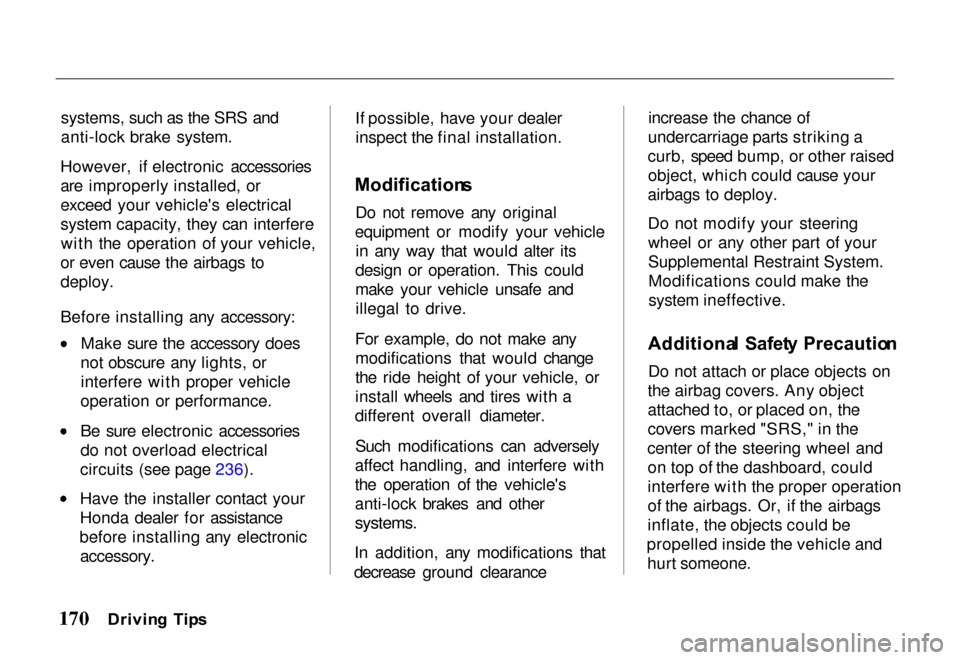
systems, such as the SRS and
anti-lock brake system.
However, if electronic accessories
are improperly installed, or
exceed your vehicle's electrical
system capacity, they can interfere with the operation of your vehicle,
or even cause the airbags to
deploy.
Before installing any accessory: Make sure the accessory does
not obscure any lights, or interfere with proper vehicle
operation or performance. Be sure electronic accessories
do not overload electrical
circuits (see page 236). Have the installer contact your
Honda dealer for assistance
before installing any electronic
accessory.
If possible, have your dealer
inspect the final installation.
Modification s
Do not remove any original
equipment or modify your vehicle in any way that would alter its
design or operation. This could
make your vehicle unsafe and illegal to drive.
For example, do not make any modifications that would change
the ride height of your vehicle, or
install wheels and tires with a
different overall diameter.
Such modifications can adversely
affect handling, and interfere with
the operation of the vehicle's
anti-lock brakes and other
systems.
In addition, any modifications that
decrease ground clearance increase the chance of
undercarriage parts striking a
curb, speed bump, or other raised object, which could cause your
airbags to deploy.
Do not modify your steering wheel or any other part of your
Supplemental Restraint System.Modifications could make the
system ineffective.
Additiona l Safet y Precautio n
Do not attach or place objects on
the airbag covers. Any object
attached to, or placed on, the
covers marked "SRS," in the
center of the steering wheel and on top of the dashboard, could
interfere with the proper operation
of the airbags. Or, if the airbags
inflate, the objects could be
propelled inside the vehicle and hurt someone.
Drivin g Tip s
Page 174 of 267
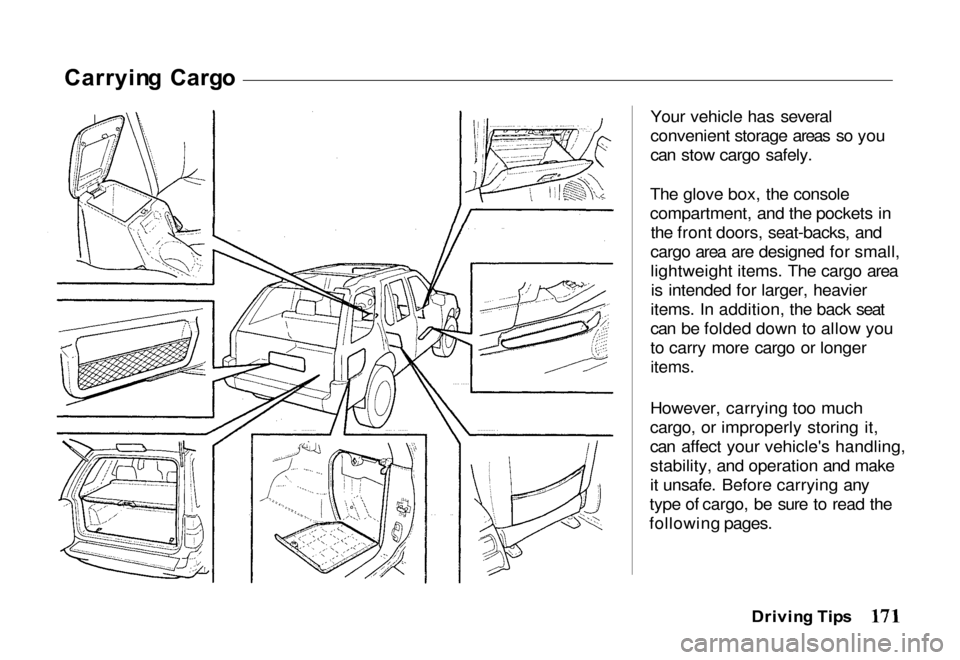
Carryin
g Carg o
Your vehicle has several
convenient storage areas so you
can stow cargo safely.
The glove box, the console
compartment, and the pockets in the front doors, seat-backs, and
cargo area are designed for small,
lightweight items. The cargo area is intended for larger, heavier
items. In addition, the back seat
can be folded down to allow you
to carry more cargo or longer
items.
However, carrying too much
cargo, or improperly storing it,
can affect your vehicle's handling,
stability, and operation and make
it unsafe. Before carrying any
type of cargo, be sure to read the
following pages.
Drivin g Tip s
Page 175 of 267
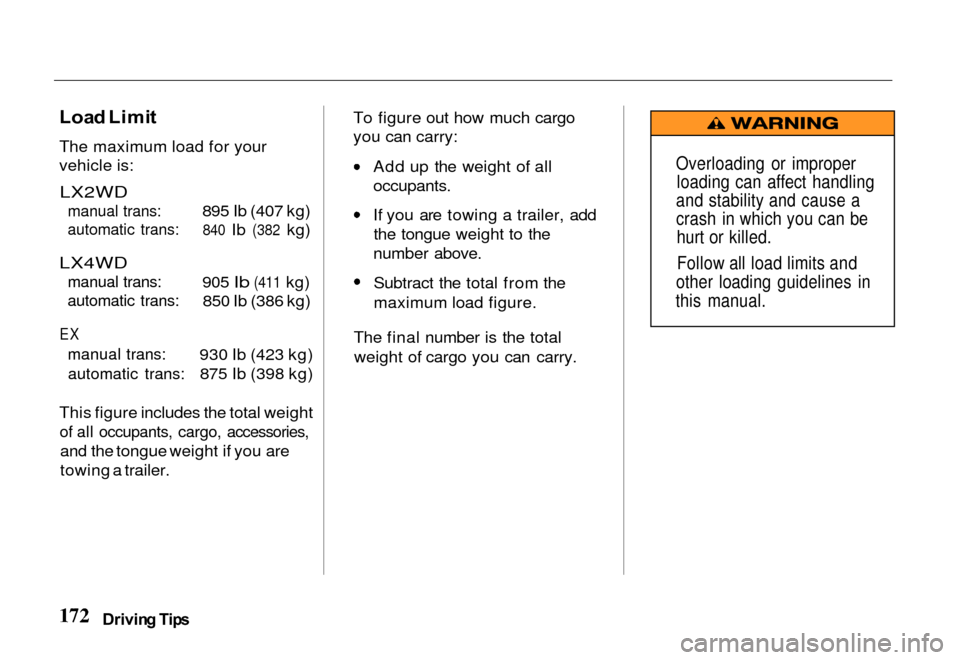
Loa
d Limi t
The maximum load for your
vehicle is:
LX2WD
manual trans:
automatic trans:
LX4WD
manual trans:
automatic trans:
EX
manual trans:automatic trans:
895 Ib (407 kg)
840
Ib
(382
kg)
905
Ib
(411
kg) 850 Ib (386 kg)
930 Ib (423 kg) 875 Ib (398 kg)
This figure includes the total weight
of all occupants, cargo, accessories,
and the tongue weight if you are
towing a trailer. To figure out how much cargo
you can carry: Add up the weight of all
occupants.
If you are towing a trailer, add
the tongue weight to the
number above. Subtract the total from the
maximum load figure.
The final number is the total weight of cargo you can carry.
Drivin g Tip s
Overloading o
r improper
loading can affect handling
and stability and cause a
crash in which you can be hurt or killed.
Follow all load limits and
other loading guidelines in
this manual.
Page 176 of 267
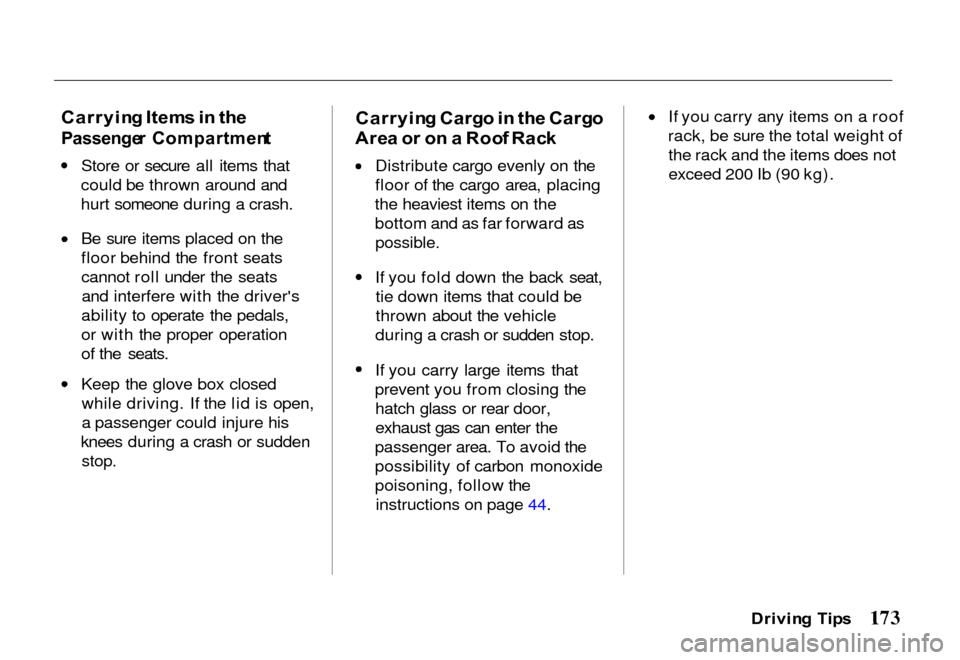
Carryin
g Item s in th e
Passenge r Compartmen t
Store or secure all items that
could be thrown around and
hurt someone during a crash. Be sure items placed on the
floor behind the front seats
cannot roll under the seats
and interfere with the driver's
ability to operate the pedals,
or with the proper operation
of the seats. Keep the glove box closed
while driving. If the lid is open,
a passenger could injure his
knees during a crash or sudden
stop.
Carryin
g Carg o in th e Carg o
Are a o r o n a Roo f Rac k Distribute cargo evenly on the
floor of the cargo area, placing
the heaviest items on the
bottom and as far forward as
possible.
If you fold down the back seat,
tie down items that could be
thrown about the vehicle
during a crash or sudden stop. If you carry large items that
prevent you from closing the hatch glass or rear door,
exhaust gas can enter the
passenger area. To avoid the
possibility of carbon monoxide
poisoning, follow the instructions on page 44. If you carry any items on a roof
rack, be sure the total weight of the rack and the items does not
exceed 200 Ib (90 kg).
Driving Tip s
Page 177 of 267
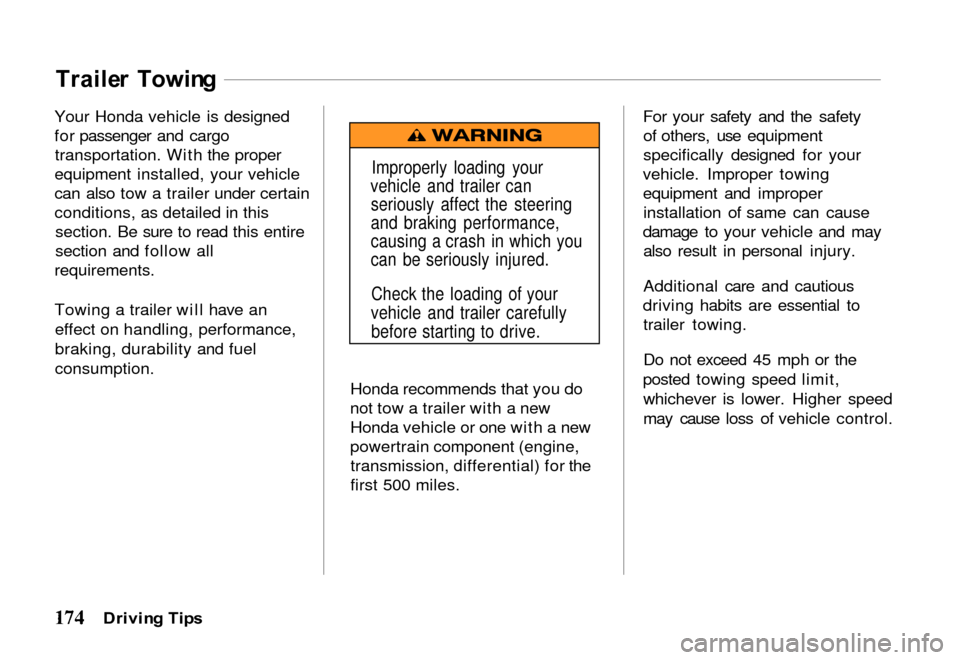
Traile
r Towin g
Your Honda vehicle is designed
for passenger and cargo transportation. With the proper
equipment installed, your vehicle
can also tow a trailer under certain
conditions, as detailed in this section. Be sure to read this entire
section and follow all
requirements.
Towing a trailer will have an
effect on handling, performance,
braking, durability and fuel
consumption.
Honda recommends that you do
not tow a trailer with a new Honda vehicle or one with a new
powertrain component (engine, transmission, differential) for the
first 500 miles. For your safety and the safety
of others, use equipment
specifically designed for your
vehicle. Improper towing
equipment and improper installation of same can cause
damage to your vehicle and may also result in personal injury.
Additional care and cautious
driving habits are essential to trailer towing.
Do not exceed 45 mph or the
posted towing speed limit, whichever is lower. Higher speed
may cause loss of vehicle control.
Drivin g Tip s
Improperly loading your
vehicle and trailer can seriously affect the steering
and braking performance,
causing a crash in which you
can be seriously injured.
Check the loading of your
vehicle and trailer carefully before starting to drive.
Page 178 of 267
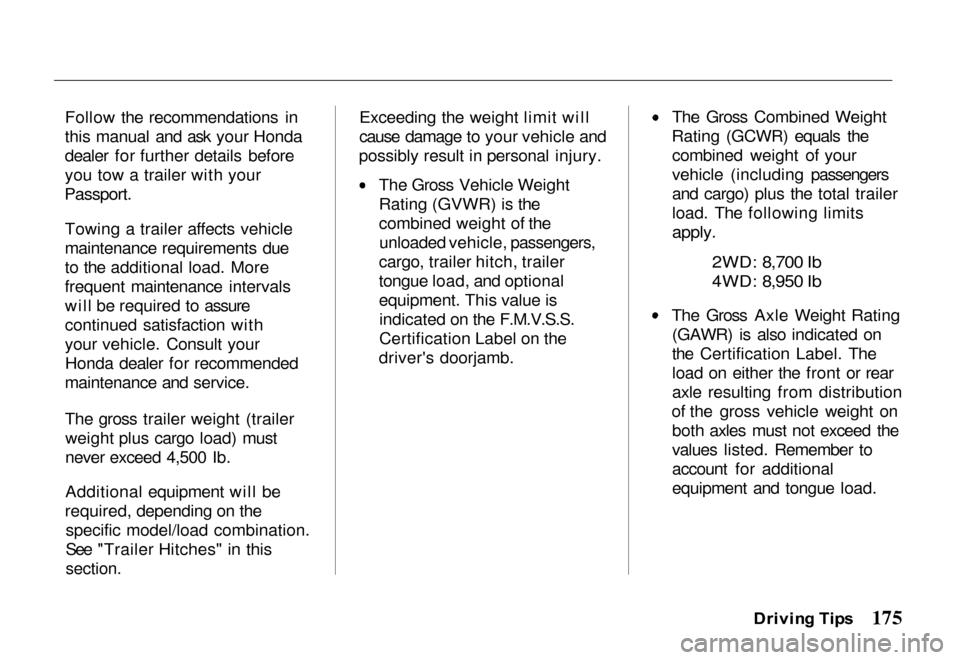
Follow the recommendations in
this manual and ask your Honda
dealer for further details before
you tow a trailer with your
Passport.
Towing a trailer affects vehicle
maintenance requirements due
to the additional load. More
frequent maintenance intervals
will be required to assure
continued satisfaction with
your vehicle. Consult yourHonda dealer for recommended
maintenance and service.
The gross trailer weight (trailer weight plus cargo load) must
never exceed 4,500 Ib.
Additional equipment will be
required, depending on the specific model/load combination.
See "Trailer Hitches" in this
section.
Exceeding the weight limit will
cause damage to your vehicle and
possibly result in personal injury. The Gross Vehicle Weight
Rating (GVWR) is the
combined weight of the
unloaded vehicle, passengers,
cargo, trailer hitch, trailer
tongue load, and optional
equipment. This value is indicated on the F.M.V.S.S.
Certification Label on the
driver's doorjamb. The Gross Combined Weight
Rating (GCWR) equals the combined weight of your
vehicle (including passengers
and cargo) plus the total trailer
load. The following limits
apply.
2WD: 8,700 Ib
4WD: 8,950 Ib
The Gross Axle Weight Rating
(GAWR) is also indicated on
the Certification Label. The
load on either the front or rear
axle resulting from distribution
of the gross vehicle weight on both axles must not exceed the
values listed. Remember to
account for additional
equipment and tongue load.
Driving Tip s
Page 179 of 267
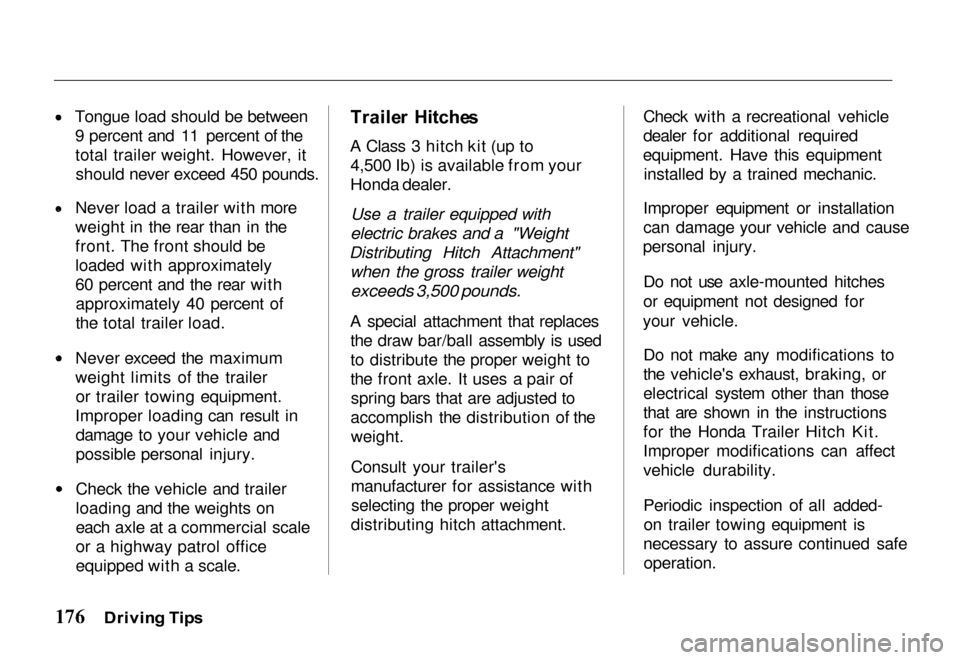
Tongue load should be between
9 percent and 11 percent of the
total trailer weight. However, itshould never exceed 450 pounds. Never load a trailer with more
weight in the rear than in the
front. The front should be
loaded with approximately
60 percent and the rear with
approximately 40 percent of
the total trailer load. Never exceed the maximum
weight limits of the trailer
or trailer towing equipment.
Improper loading can result in damage to your vehicle and
possible personal injury. Check the vehicle and trailer
loading and the weights on
each axle at a commercial scale
or a highway patrol office
equipped with a scale.
Traile
r Hitche s
A Class 3 hitch kit (up to 4,500 Ib) is available from your
Honda dealer.
Use a trailer equipped with
electric brakes and a "Weight
Distributing Hitch Attachment" when the gross trailer weight
exceeds 3,500 pounds.
A special attachment that replaces the draw bar/ball assembly is used
to distribute the proper weight to
the front axle. It uses a pair ofspring bars that are adjusted to
accomplish the distribution of the weight.
Consult your trailer's
manufacturer for assistance withselecting the proper weight
distributing hitch attachment. Check with a recreational vehicle
dealer for additional required
equipment. Have this equipment installed by a trained mechanic.
Improper equipment or installation
can damage your vehicle and cause
personal injury.
Do not use axle-mounted hitches
or equipment not designed for
your vehicle.
Do not make any modifications to
the vehicle's exhaust, braking, or
electrical system other than those
that are shown in the instructions
for the Honda Trailer Hitch Kit.
Improper modifications can affect
vehicle durability.
Periodic inspection of all added-on trailer towing equipment is
necessary to assure continued safe
operation.
Drivin g Tip s
Page 180 of 267

Safet
y Chai n
Always use a suitable safety chain
between your vehicle and the
trailer.
Check with your trailer
manufacturer for the required
equipment. Cross the safety
chains under the hitch and attach
them to the trailer hitch hardware.
This will prevent the trailer from
dropping to the ground in the
event the hitch disengages. For
proper use and installation,
consult your trailer manufacturer.
Traile r Light s
Trailer lights and equipment must
comply with federal, state and local regulations. Check with your
local recreational vehicle dealer
for the requirements in your area. Use only equipment designed for
your vehicle.
Improper equipment or installation can cause damage to
your vehicle's electrical system and affect your vehicle warranty.
Consult your Honda dealer for installation.
Tire s
Always check the condition of
your vehicle's tires and trailer's
tires before operation. Replace
worn or damaged tires before
operation.
Inflate tire pressure to the
recommended cold tire pressure indicated in the tire
manufacturer's warranty booklet in the glove box packet.
Check the tire manufacturer's
requirements when replacement
tires are installed on your vehicle.
Trailer tire condition, size, load
rating, and proper inflation
pressure should be in accordance
with the tire manufacturer's
specifications. Improper tire size
and inflation can cause tire
failure, possibly resulting in
vehicle damage and personal
injury.
Traile r Brake s
Trailers with a total weight of
1,000 pounds or more require trailer brakes. If your trailer is
equipped with a braking system,
make sure it conforms to federal,state, and local equipment
regulations.
Driving Tip s